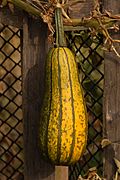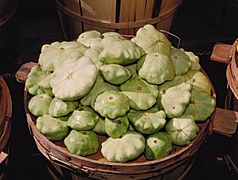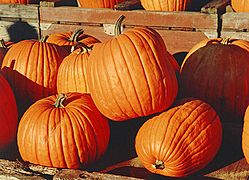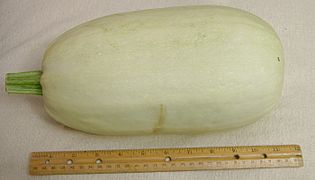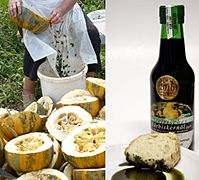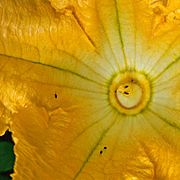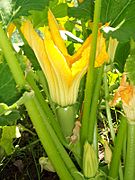Cucurbita pepo facts for kids
Quick facts for kids Cucurbita pepo |
|
|---|---|
 |
|
| Different types of Cucurbita pepo, including pattypan squash, yellow summer squash, zucchini, and pumpkins | |
| Conservation status | |
| Scientific classification | |
| Synonyms | |
|
Cucurbita pepo is a type of plant that belongs to the Cucurbita family. It gives us many different kinds of winter squash and pumpkin. However, the most common types are part of the group called Cucurbita pepo subsp. pepo, which we know as summer squash.
This plant has been grown by people in the Americas for thousands of years. Some scientists think C. pepo came from a wild plant called C. texana. Others believe C. texana is actually C. pepo that grew wild again. C. pepo is used in many ways, especially as food and sometimes for traditional medicine. It is also a food source for insects like the melonworm moth and squash vine borer. Squash bees also love its pollen.
Contents
The Amazing History of Cucurbita Pepo
The many types of C. pepo look so different that people sometimes thought they were completely separate species. This is because C. pepo grows in many different places around the world. It is one of the oldest, if not the oldest, plants that humans have grown.
Scientists have found the oldest known C. pepo plants in southern Mexico, dating back 8,000–10,000 years ago. It also grew north into Texas and along the Mississippi River into Illinois and Florida. It was one of the important plants grown in ancient North America. Some types of C. pepo grow in dry areas, while others prefer moist places.
Different Types of Cucurbita Pepo
There are many different kinds of C. pepo. They vary a lot in shape and color. Here are some of the main groups:
| Cultivar group | Botanical name | Image | What it looks like |
|---|---|---|---|
| Acorn | C. pepo var. turbinata |  |
A winter squash shaped like a spinning top, pointed at one end with grooves. Example: Acorn squash. |
| Cocozelle | C. pepo var. ionga |  |
A long, slender summer squash, slightly wider at the end. Example: Cocozelle von tripolis. |
| Crookneck | C. pepo var. torticollia |  |
A summer squash that is yellow or white, long, and curved at the end. It often has a bumpy skin. Example: Yellow crookneck squash. |
| Pumpkin | C. pepo var. pepo |
 |
A winter squash, usually round or oval. This group includes the pumpkins we see at Halloween. |
| Scallop | C. pepo var. clypeata |  |
A summer squash that is flat or slightly disc-shaped, with wavy edges. Example: Pattypan squash. |
| Straightneck | C. pepo var. recticollis |  |
A yellow summer squash with bumpy skin, similar to crookneck but with a straight neck. Example: Yellow summer squash. |
| Vegetable marrow | C. pepo var. fastigata |  |
Can be a summer or winter squash, cream to dark green, short and round with a slightly wide top. Example: Spaghetti squash. |
| Zucchini (US) Courgette (UK, IE) |
C. pepo var. cylindrica | A very common summer squash, long and cylindrical. Example: Zucchini. | |
| Ornamental gourds | C. pepo var. ovifera | 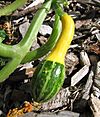 |
These are not for eating. They are often egg-shaped, pear-shaped, orange, or bumpy. |
What Cucurbita Pepo Looks Like
Because of their different backgrounds, C. pepo plants can look very different, especially their fruits. The plants are usually about 1 to 2.5 feet tall and 2 to 3 feet wide. They have yellow flowers. The pumpkins, scallops, and some crooknecks are very old types that were grown separately. The plants that people grow tend to have bigger fruits but fewer seeds.
Popular Varieties of Cucurbita Pepo
C. pepo includes a wide range of well-known varieties:
- Acorn squash
- Delicata squash
- Dodi marrow, grown in South Asia
- Gem squash
- Heart of gold squash
- Kamo kamo, also called kumi kumi, a special heirloom squash grown by the Māori people of New Zealand
- Many types of ornamental squash (often called "gourds")
- Pattypan squash
- Several types of pumpkin
- Spaghetti squash
- Sweet dumpling squash
- Yellow crookneck squash
- Yellow summer squash
- Zucchini, also known as courgette
How People Use Cucurbita Pepo
C. pepo is used in many ways. It can be an ingredient in traditional foods like "schumaakwe cakes." Some people use it on the skin for aches and swelling. A paste made from seeds and flowers can be put on cactus scratches.
Fresh squash can be cut into strips and dried for use in winter. The flowers are sometimes cooked and eaten as a special treat. Whole or cut pieces of fresh squash can be roasted in ashes and eaten. The hard shells of gourds can be made into cups, ladles, and dippers. Gourds are also used in dances to represent growth or made into ceremonial rattles. Sometimes, gourds are even used to store special items.
Gallery
See also
 In Spanish: Cucurbita pepo para niños
In Spanish: Cucurbita pepo para niños



